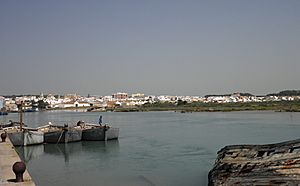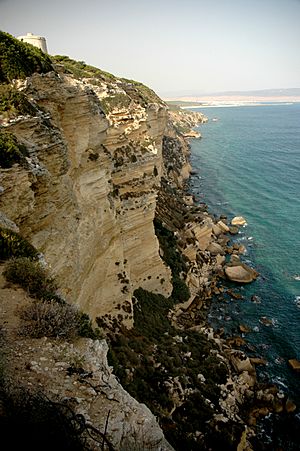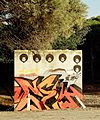Barbate facts for kids
Quick facts for kids
Barbate
|
|||
|---|---|---|---|
 |
|||
|
|||
| Nickname(s):
The Tuna's Town
|
|||
| Country | Spain | ||
| Autonomous community | Andalucía | ||
| Province | Cádiz | ||
| Area | |||
| • Total | 142.17 km2 (54.89 sq mi) | ||
| Elevation | 14 m (46 ft) | ||
| Population
(2018)
|
|||
| • Total | 22,551 | ||
| • Density | 158.620/km2 (410.824/sq mi) | ||
| Demonym(s) | Barbateño, ña | ||
| Time zone | UTC+1 (CET) | ||
| • Summer (DST) | UTC+2 (CEST) | ||
| Postal code |
11160
|
||
| Website | barbate.es | ||
Barbate is a charming coastal town in Spain, located in the Province of Cádiz within the region of Andalusia. It sits right on the Atlantic Ocean, not far from the famous Strait of Gibraltar. Barbate is known for its beautiful beaches and its long history of fishing, especially for tuna. About 22,500 people live here.
Contents
Exploring Barbate's Location
Barbate is found where the River Barbate meets the sea. It's about 11 kilometers (7 miles) east of Cape Trafalgar. The town is also part of a special protected area called the La Breña y Marismas del Barbate Natural Park.
What is the Tómbolo de Trafalgar?
A cool natural spot nearby is the "Tómbolo de Trafalgar." This is a sandy strip of land that connects Cape Trafalgar to the mainland. It's a unique geographical feature to explore.
Barbate's Region
Barbate belongs to a larger area in Spain known as the comarca of La Janda.
A Look at Barbate's Past
Barbate has a very old history, going back to Roman times. People believe it might have been an ancient Roman town called Baessipo. During that time, salting fish was a big industry here.
Name Change Over Time
For a while, starting in the 1930s, the town was called Barbate de Franco. This was because a famous general, Francisco Franco, used to spend his free time there. However, in 1998, the local government decided to change the name back to just Barbate.
Barbate Today
Today, Barbate is a popular spot for Spanish tourists, especially in the summer. The town has a main square called "Plaza de la Inmaculada." You can find the Town Hall and the Church of St. Paul there.
Fun Festivals in Barbate
Barbate loves to celebrate! Here are some of the exciting festivals held throughout the year:
- Carnival: This lively festival happens in February or March, usually a week after the big Carnival in Cádiz. A special building is set up by the river for shows, funny plays, and music. The Six Taps Square is a busy place during this time.
- Holy Week: The week before Easter is celebrated with religious parades. These processions move through the streets from Palm Sunday all the way to Good Friday and Easter Sunday.
- Tuna Gastronomy Week: Since 2008, Barbate has celebrated its most famous fish, tuna! This week is like a fair with temporary stands, local shops, and other fun attractions. It highlights how important tuna is to the town's economy.
- St John's Night: On the evening of June 23rd, people burn large figures made to look like local heroes, celebrities, or politicians. After the bonfires, it's a tradition to go to the beach to cool off.
- St. Carmen's Fair (Feria del Carmen): Held on July 16th, this fair celebrates the patron saint of fishermen and the town.
- The Great Sardine Festival (La Gran Sardina): This tasty festival takes place in the port area. It's a chance to enjoy the sardine season and all the delicious dishes made with them.
Nearby Places to Visit
If you're exploring the area around Barbate, you might want to check out these charming villages:
Barbate's Beautiful Beaches
This part of the coast is famous for its many lovely beaches. Some of them include:
- Mangueta
- Zahora
- Los Caños de Meca
- Hierbabuena
- Nuestra Señora del Carmen
- Cañillos
- Pajares
- Zahara de los Atunes
Barbate's Economy
The main ways people make a living in Barbate are through fishing, rural tourism, and the beautiful beaches. These industries bring many visitors and jobs to the town.
Images for kids
See also
 In Spanish: Barbate para niños
In Spanish: Barbate para niños












